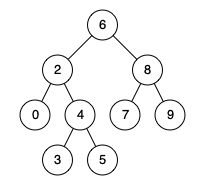Given a binary search tree (BST), find the lowest common ancestor (LCA) node of two given nodes in the BST.
According to the definition of LCA on Wikipedia: “The lowest common ancestor is defined between two nodes p and q as the lowest node in T that has both p and q as descendants (where we allow a node to be a descendant of itself).”
Example 1:

Input: root = [6,2,8,0,4,7,9,null,null,3,5], p = 2, q = 8 Output: 6 Explanation: The LCA of nodes 2 and 8 is 6.
Example 2:

Input: root = [6,2,8,0,4,7,9,null,null,3,5], p = 2, q = 4 Output: 2 Explanation: The LCA of nodes 2 and 4 is 2, since a node can be a descendant of itself according to the LCA definition.
Example 3:
Input: root = [2,1], p = 2, q = 1 Output: 2
Constraints:
- The number of nodes in the tree is in the range
[2, 105]. -109 <= Node.val <= 109- All
Node.valare unique. p != qpandqwill exist in the BST.
根据val , 看左边右边
public class Solution {
public TreeNode lowestCommonAncestor(TreeNode root, TreeNode p, TreeNode q) {
if(p.val > q.val)
return lowestCommonAncestor(root,q,p);
return helper(root,p,q);
}
private TreeNode helper(TreeNode root, TreeNode p, TreeNode q) {
if(root.val<p.val)
return helper(root.right,p,q);
else if(root.val > q.val)
return helper(root.left,p,q);
return root;
}
}
其实这道题,无关Binary Search Tree ---虽然利用起来,效率会高一些些
/*** Definition for a binary tree node.* struct TreeNode {* int val;* TreeNode *left;* TreeNode *right;* TreeNode(int x) : val(x), left(NULL), right(NULL) {}* };*/class Solution {public:TreeNode* lowestCommonAncestor(TreeNode* root, TreeNode* p, TreeNode* q) {if(!root)return root;if(root->val == p->val || root->val == q->val){return root;}auto l = lowestCommonAncestor(root->left, p, q);auto r = lowestCommonAncestor(root->right, p, q);if(l&&r){return root;}else{return l?l:r;}}};
Mistakes:
No comments:
Post a Comment